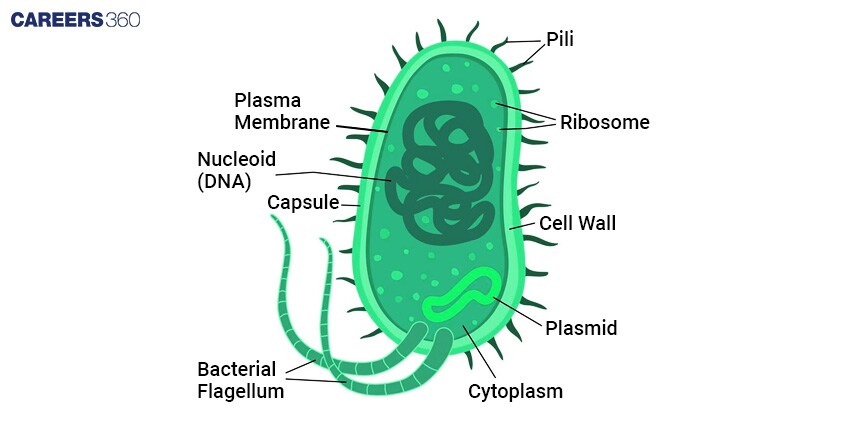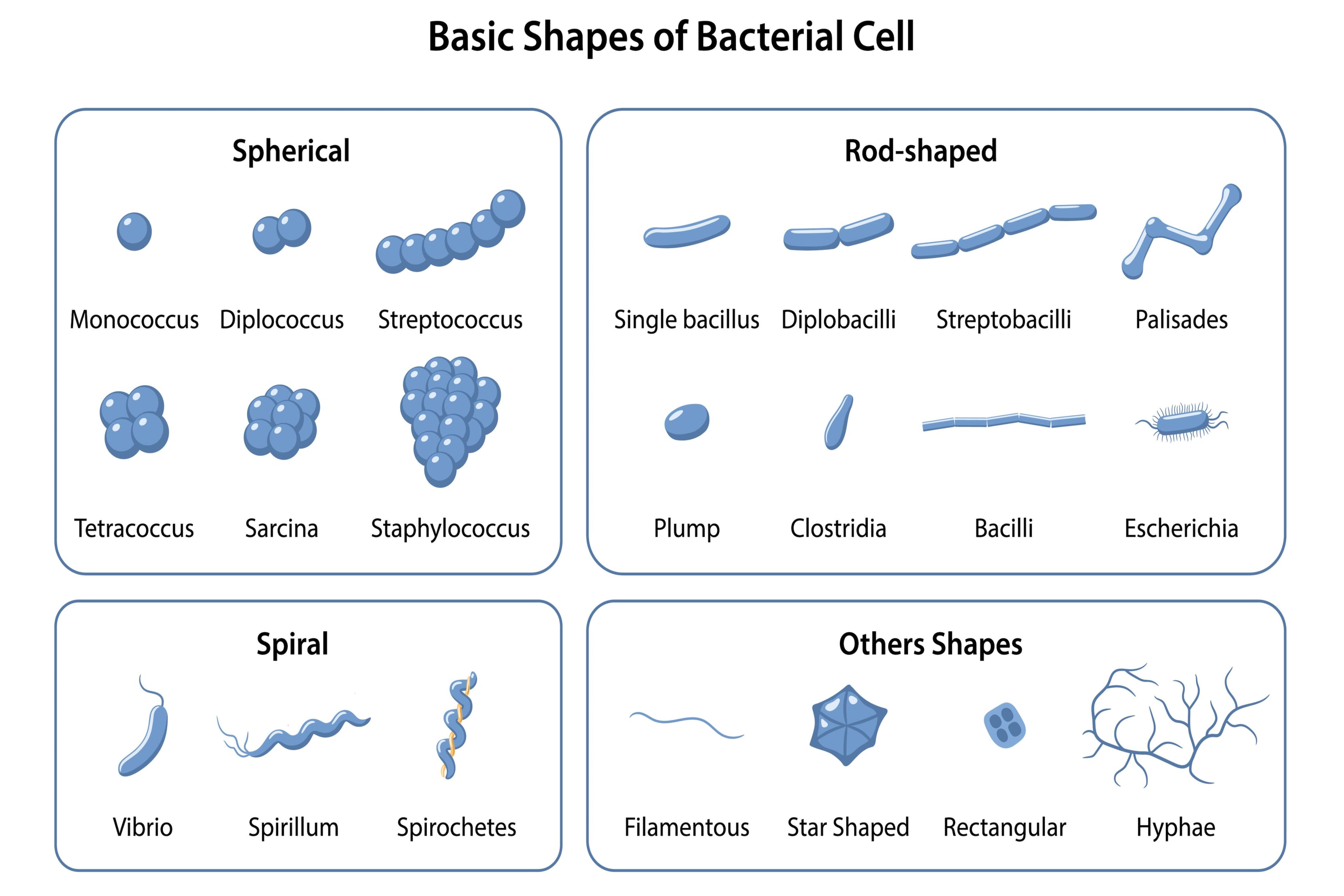Monera: Definition, Classification, Characteristics, Structure, Examples
The Kingdom Monera is home to the most primitive and basic forms of life. Prokaryotic cells are unicellular organisms without a true nucleus or membrane-bound organelles. The two main groups that make up this kingdom are bacteria and archaea. Under a microscope, monerans seem small and basic. Since they lack a true nucleus, their genetic material circulates freely throughout the cell. They reproduce asexually by binary fission, which is a simple process in which one cell divides into two identical cells.
This Story also Contains
- What is the Kingdom Monera?
- Classification of Monera
- Kingdom Monera Characteristics
- Bacteria: A Major Group in Monera
- Pathogenic Bacteria
- Economic Importance
- Recommended Video on Monera:

Monerans inhabit a variety of environments, such as salty lakes, hot springs, icy areas, and soil, water, and air. They play important roles in nature, such as assisting in digestion and decomposition, despite their small size. Despite being tiny, they play very important roles in nature, such as helping in digestion, breaking down waste, and even making medicines. Monera is a topic in the chapter Biological Classification in Biology.
What is the Kingdom Monera?
The five kingdoms of biological classification include Monera. It comprises unicellular and prokaryotic organisms. They can be either unicellular or multicellular. These are organisms with no true nuclei or membrane-bound organelles, a characteristic that demarcates them from eukaryotic cells. Monera has a wide range of diversity in terms of shape and metabolic types. Since monera are found in almost all environments, they range from deep oceans to extreme hot springs.
The significance of studying Monera organisms lies in their important roles in nearly all ecological and biological processes, ranging from nutrient cycling and decomposition to nitrogen fixation. They are, additionally, of high importance in medicine, agriculture, and industry, whereby they span antibiotic production to genetic engineering. They also offer knowledge helpful for the control of infectious diseases and new biotechnological developments.
Also read-
Classification of Monera
Kingdom Monera includes all prokaryotic organisms and is broadly classified into Archaebacteria and Eubacteria based on their genetic and biochemical characteristics. Monerans are classified based on various characteristics:
Based on Shape
This section explains how Monerans are classified by their physical shape. It includes forms like spherical, rod-shaped, spiral, and comma-shaped bacteria.
Cocci: Spherical-shaped bacteria.
Bacilli: Rod-shaped bacteria.
Spirilla: Spiral or corkscrew-shaped bacteria.
Vibrios: Comma-shaped bacteria.
Based on Gram Staining
Here, Monerans are divided based on how they react to a Gram staining test. This helps identify bacteria as either Gram-positive or Gram-negative.
Gram-positive: These bacteria retain the crystal violet stain and appear purple under the microscope.
They have a thick peptidoglycan layer in their cell wall, which holds the stain strongly.Gram-negative: These bacteria do not retain the crystal violet stain and instead take up safranin, appearing pink/red.
They have a thin peptidoglycan layer and an outer membrane, which makes them harder to stain.
Based on Nutrition
This part shows how Monerans obtain their food. They can be autotrophic (make their own food) or heterotrophic (depend on others).
Autotrophs: They make their own food using simple things like sunlight, water, and air. They don’t need to eat other living things because they can produce food by themselves.
Heterotrophs: They cannot make their own food and must eat plants or animals to survive. They get energy by consuming organic substances made by other living things.
Based on Respiration
This section explains how Monerans breathe or use gases for survival. They may use oxygen (aerobic) or survive without it (anaerobic).
Aerobic: They require oxygen for respiration. These organisms need oxygen to break down food and get energy. They use oxygen during respiration to stay alive and active.
Anaerobic: These organisms do not need oxygen to survive or get energy. Sometimes oxygen can even be harmful to them, so they live without it.
Based on Reproduction
This explains the ways in which Monerans reproduce. Most of them divide asexually by binary fission, but some show gene transfer.
Binary fission: A process of asexual reproduction in which the cell divides into two identical daughter cells.
Budding: A type of asexual reproduction in which a new organism develops from an outgrowth or bud due to cell division at one specific site.
Endospore formation: A survival mechanism in which the bacterium produces a tough resistant spore in which to withstand unfavourable conditions.
Kingdom Monera Characteristics
Organisms in Monera are unicellular, prokaryotic, lack a true nucleus, and reproduce mostly through binary fission. They can be autotrophic or heterotrophic and thrive in diverse environments. The characteristics of monera are defined as:
Cell Structure
This section describes the simple, prokaryotic structure of Monerans. They lack membrane-bound organelles and have a basic cell wall.
Lack of a true membrane-bound nucleus and membrane-bound organelles.
Cell wall composition is mostly peptidoglycan.
There is no nuclear membrane that surrounds the genetic material.
However, protein synthesis occurs in these ribosomes, which turn out to be smaller as compared to those of the eukaryotes.
Involvement of the plasma membranes with mesosomes in cellular processes such as respiration and replication of DNA.
Genetic Material
Here we focus on the DNA of Monerans. They have a single circular chromosome and may contain plasmids.
- Circular DNA molecule located within the nucleoid region, not membrane-bounded.
- Small, circular pieces of DNA that are called plasmids replicate independently of the chromosomal DNA. Often, these carry genes for antibiotic resistance and other functions.
Metabolism
This part talks about the chemical processes inside Monera. Some bacteria are very active and can survive in extreme conditions.
- Autotrophic: These bacteria use sunlight to synthesise food, e.g., cyanobacteria. Some also use chemical reactions to obtain energy, e.g., nitrifying bacteria.
- Heterotrophic: These bacteria decompose and absorb nutrients from dead organic matter. They obtain nutrients from living hosts, often causing disease.
Bacteria: A Major Group in Monera
Bacteria are the most dominant group in Monera and exhibit various shapes like cocci, bacilli, and spirilla. They play important roles in ecosystems, from decomposing organic matter to nitrogen fixation. The different types and examples of bacteria are classified as:
Archaebacteria
This section describes a special group of Monerans that live in extreme environments. They include methanogens, halophiles, and thermoacidophiles.
Methanogens: Methanogens are microorganisms that live in oxygen-free (anaerobic) environments and produce methane gas during respiration. They are commonly found in the guts of ruminants like cows and in sewage treatment plants.
Halophiles: Halophiles are microbes that thrive in extremely salty environments such as salt lakes, salt pans, and marshes. They have special adaptations that help them survive and grow in high salt concentrations.
Thermoacidophiles: Thermoacidophiles are microorganisms that survive in both very hot and highly acidic conditions. They are found in extreme places like hot springs, acidic soils, and volcanic vents.
Eubacteria
This part explains the true bacteria found everywhere around us. It includes helpful forms like cyanobacteria and actinobacteria.
Eubacteria are true bacteria – unicellular, prokaryotic organisms found in diverse environments like soil, water, and inside other organisms.
They have a rigid cell wall made of peptidoglycan, which provides shape and protection.
Cyanobacteria (e.g., Nostoc, Anabaena) are photosynthetic eubacteria, often called blue-green algae.
Actinobacteria (e.g., Streptomyces) are filamentous bacteria known for producing antibiotics.
Eubacteria reproduce asexually by binary fission, but can also exchange genetic material through conjugation.
Bacteria Diagram
The diagram given below shows the bacterial cell and its components. The capsule is the outermost protective layer that helps the bacteria survive tough environments and stick to surfaces. The cell wall provides shape and support, while the plasma membrane controls what enters and exits the cell. Inside, the cytoplasm is a jelly-like fluid where various chemical reactions take place. The nucleoid holds the bacterial DNA, though it's not enclosed in a nucleus, and plasmids are small circular DNA pieces that often carry useful genes like antibiotic resistance. Ribosomes are present for protein synthesis. On the surface, pili help the cell attach to surfaces and may assist in sharing DNA, while the flagella (or flagellum) allow the bacteria to move around.

Pathogenic Bacteria
Some bacteria in Monera cause diseases in humans, animals, and plants, such as Mycobacterium tuberculosis (tuberculosis) and Salmonella (typhoid). This section focuses on Monerans that cause diseases. They can infect humans, animals, or plants and lead to serious illnesses.
Tuberculosis: This is caused by Mycobacterium tuberculosis. It mainly attacks the lungs. spots. The general symptoms are chronic coughing, fever, and loss of weight.
Cholera: This is caused by Vibrio cholerae. There is acute diarrhoea and dehydration that will lead to death unless treated.
Typhoid: Typhoid is an illness caused by a type of bacteria called Salmonella typhi. This bacterium enters the body through contaminated food or water and causes fever and stomach problems.
Pneumonia: Pneumonia is an infection of the lungs that can make breathing very hard. Many cases happen because of bacteria called Streptococcus pneumoniae that infect the lungs.
Plant diseases: Plant diseases caused by pathogenic bacteria cause massive destruction to crops, amounting to heavy agricultural losses.
The excessive epidemic of bacterial blight in crops such as rice and beans, for instance, is one that massively impairs food production through symptoms such as wilting and leaf spots that lead to reduced yield.
Economic Importance
Bacteria are used in industries for fermentation, production of antibiotics, bioremediation, and in agriculture for soil fertility through nitrogen fixation. This part explains how bacteria can be useful to humans. They help in food production, medicine, nitrogen fixation, and biotechnology.
- Bacteria are used in the production of antibiotics such as penicillin and streptomycin. These are used in the treatment of bacterial infections in humans and domestic animals. They supply enzymes, vitamins, and other biochemicals that are used internally in industries.
- Rhizobium forms symbiotic relationships with leguminous plants; for instance, peas and beans. They help fix nitrogen from the air into ammonia, used by the plant to grow. The plant provides carbon and shelter to the bacteria.
- Some bacteria-for instance, plant growth produce growth-promoting substances and protect plants from pathogens; they therefore promote the growth of plants. The process is very important in fermentation because bacteria, here, convert sugars into alcohol, acids, or gases. This, therefore, aids in the production of food products such as yoghurt, cheese, vinegar, and bread.
- Some bacteria play an important role in the digestion of the host by degrading complex carbohydrates that the host is not able to digest itself. The microbes also synthesise vitamins and other compounds useful to the nutrition and good health of the host.
- Biofilms are communities of bacteria that attach to surfaces through a self-produced extracellular polymeric substance (EPS) matrix. They develop on surfaces such as rocks, medical implants, and teeth, creating either beneficial, as in wastewater treatment or detrimental, for example, dental plaques. Biofilms provide a very high degree of protection from antibiotics and immunological responses, hence increased survival in hostile environments
Also Read-
Recommended Video on Monera:
Frequently Asked Questions (FAQs)
Bacteria maintain ecological balance. They perform nitrogen cycling by fixing all the nitrogen present in the air into inorganic compounds that plants can use. They decompose organic matter breaking down dead plants and animals. They clean the environment through bioremediation by degrading the natural pollutants or contaminants.
Tuberculosis, cholera, typhoid, and pneumonia are the most common diseases caused by some pathogenic bacteria.
In the laboratory, bacteria are studied through staining techniques, culture methods, and microscopy.
Monera is one of five kingdoms of prokaryotic organisms comprising bacteria and archaea that have no true, membrane-bound nucleus and no membrane-bound organelles.
Based on shape, Gram staining, nutrition, respiration, and reproduction methods, the bacteria from Monera are classified into different groups.
